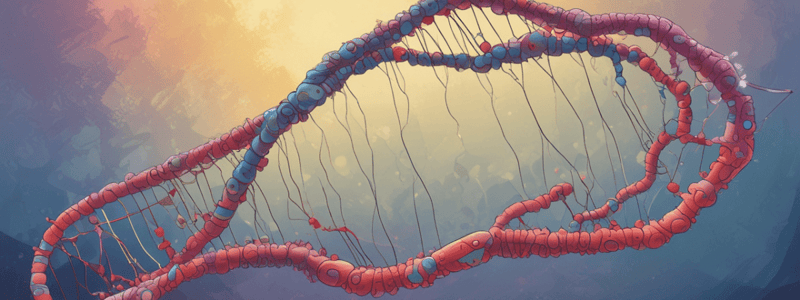Podcast
Questions and Answers
What is the primary function of splicing factors in RNA splicing?
What is the primary function of splicing factors in RNA splicing?
- To catalyze the hydrolysis of phosphodiester bonds
- To recognize and define exons (correct)
- To translate mRNA into protein
- To degrade aberrant RNA molecules
What is the result of exon skipping in alternative splicing?
What is the result of exon skipping in alternative splicing?
- An intron is retained in the mature RNA
- A new exon is created in the mature RNA
- An exon is duplicated in the mature RNA
- An exon is excluded from the mature RNA (correct)
What is the purpose of exonic splicing enhancers (ESEs)?
What is the purpose of exonic splicing enhancers (ESEs)?
- To recognize intron-exon boundaries
- To promote exon inclusion (correct)
- To degrade aberrant RNA molecules
- To inhibit exon inclusion
In which stage of RNA splicing do introns get removed?
In which stage of RNA splicing do introns get removed?
What is the primary function of heterogeneous nuclear ribonucleoproteins (hnRNPs)?
What is the primary function of heterogeneous nuclear ribonucleoproteins (hnRNPs)?
How do cellular signaling pathways influence RNA splicing?
How do cellular signaling pathways influence RNA splicing?
What percentage of introns are estimated to be recognized by the GU-AG spliceosome?
What percentage of introns are estimated to be recognized by the GU-AG spliceosome?
Which U-snRNA variant is equivalent to U4?
Which U-snRNA variant is equivalent to U4?
What is the consequence of having distinct consensus sequences in the U-snRNA variants?
What is the consequence of having distinct consensus sequences in the U-snRNA variants?
Which type of intron is the least frequent?
Which type of intron is the least frequent?
What is the role of the U5V variant in the splicing process?
What is the role of the U5V variant in the splicing process?
Flashcards are hidden until you start studying
Study Notes
RNA Splicing
- Definition: Process by which introns (non-coding regions) are removed and exons (coding regions) are joined to form a mature RNA molecule
- Occurs in: Eukaryotic cells, during post-transcriptional modification of precursor mRNA (pre-mRNA)
- Two stages:
- Splicing: Intron removal and exon ligation
- Ligation: Formation of a phosphodiester bond between exons
Alternative Splicing
- Definition: Process by which different exons are selectively included or excluded to generate multiple isoforms from a single gene
- Occurs in: 95% of human multi-exon genes
- Types of alternative splicing:
- Exon skipping: Exon is excluded from the mature RNA
- Intron retention: Intron is retained in the mature RNA
- Alternative donor/acceptor sites: Different splice sites are used
- Mutually exclusive exons: One exon is included at the expense of another
- Regulation: Tissue-specific, developmental stage-specific, and signal transduction pathway-dependent
Splicing Factors
- Definition: Proteins that facilitate or regulate splicing
- Types of splicing factors:
- SR proteins: Arginine-serine-rich (SR) proteins, involved in splice site recognition and exon definition
- Heterogeneous nuclear ribonucleoproteins (hnRNPs): Involved in exon skipping, intron retention, and alternative splice site selection
- Splicing factor 1 (SF1): Binds to the branch point sequence and facilitates splicing
- Functions:
- Splice site recognition
- Exon definition
- Intron recognition
- Spliceosome assembly
Splicing Regulation
- Definition: Mechanisms that control and modulate splicing
- Regulatory elements:
- Exonic splicing enhancers (ESEs): Sequences that promote exon inclusion
- Exonic splicing silencers (ESSs): Sequences that inhibit exon inclusion
- Intronic splicing enhancers (ISEs): Sequences that promote intron inclusion
- Intronic splicing silencers (ISSs): Sequences that inhibit intron inclusion
- Regulation by splicing factors: Splicing factors can act as activators or repressors of splicing
- Cellular signaling pathways: Can regulate splicing through post-translational modifications of splicing factors
Studying That Suits You
Use AI to generate personalized quizzes and flashcards to suit your learning preferences.




